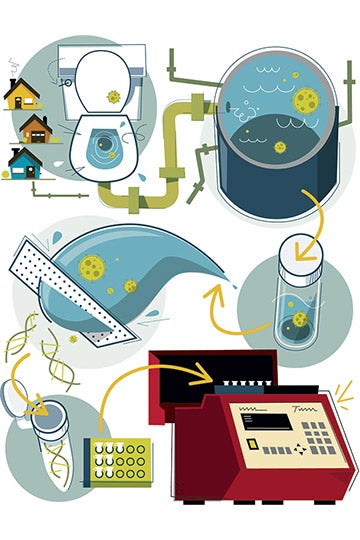
Testing the Water
Houston’s wastewater treatment plants have emerged as a key source of data about the spread of COVID-19.
By Mike Williams
Rice engineers and statisticians have worked for months to help the city of Houston monitor the spread of COVID-19 through traces of the coronavirus found in wastewater treatment plants.
Because the virus responsible for the disease can be found in stool regardless of an infected person’s symptoms, treatment plants offer a reliable source of data about how it has moved throughout the city. Beginning last summer and working with the Houston Health Department and Baylor College of Medicine, Rice experts helped track disease dynamics in close to real time by monitoring the city’s 39 wastewater treatment plants, which serve 2.1 million people spread over 670 square miles.
The team collects samples from each plant every Tuesday for rapid analysis at Rice and Baylor. Project lead Lauren Stadler, a Rice assistant professor of civil and environmental engineering, said having so many plants to draw upon “allows us to identify specific areas that are experiencing a higher burden of infection and areas that may be experiencing rapid community spread.”
“Tracking the virus in wastewater provides an unbiased estimate of the extent of the virus compared with relying solely on clinical testing,” said Loren Hopkins ’89, the Houston Health Department’s chief environmental science officer and a professor in the practice of statistics at Rice.
It gives the city what amounts to an early warning system that allows the health department to identify problem areas and institute measures including increased testing and outreach and education to slow the spread.
“Tracking the virus in wastewater provides an unbiased estimate of the extent of the virus compared with relying solely on clinical testing,” said Loren Hopkins ’89, the Houston Health Department’s chief environmental science officer and a professor in the practice of statistics at Rice.

As infections spiked across the nation last fall, the department expanded testing to cover 60 schools in high positive-rate areas and 15 nursing homes. “Wastewater levels increased slightly (in late October), which is consistent with our findings that wastewater leads positivity rates by about two weeks,” Stadler said.
“Tracking the virus in wastewater provides an unbiased estimate of the extent of the virus compared with relying solely on clinical testing,” said Loren Hopkins ’89, the Houston Health Department’s chief environmental science officer and a professor in the practice of statistics at Rice. “The hope is to continue using this method to help inform public health decisions regarding interventions to control the virus.” Hopkins pitched the project in early 2020, acquiring seed funding from the Rice COVID-19 Research Fund and additional funding from the city.
The strategy is a viable way to essentially test an entire community at once, said Katherine Ensor, the Noah G. Harding Professor of Statistics, whose team built the statistical models that draw a comprehensive picture of viral trends in Greater Houston. “The wastewater gives us a more complete picture than testing because it accounts for everyone, not just people who get tested,” Ensor said.
Stadler said several other American cities are mounting similar programs, but Houston is unique for its large number of plants, which helps pinpoint outbreaks. “I think we’re pretty far ahead of the curve,” she said. “Not too many cities have the complexity we have.”
